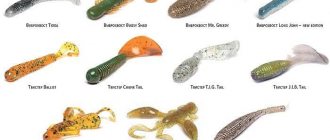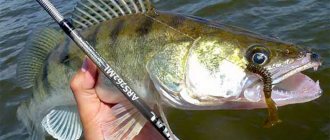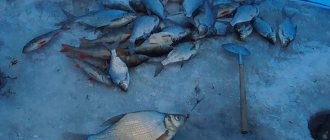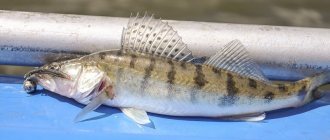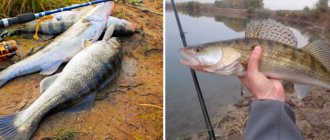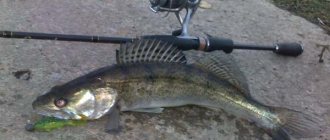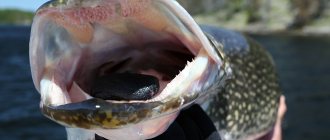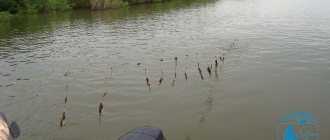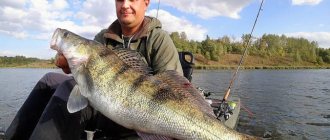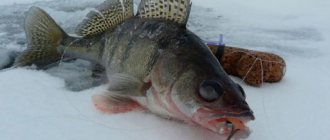The best fishing tackle for pike perch is the time-tested donka. Despite its outward primitiveness, it allows you to hunt fanged predators even with irregular biting. This is impossible when using a spinning rod in any interpretation, since fishing becomes unstable and short-term. And the donka is installed for a long time in a promising place, which increases the chances of a good result.
Large pike perch is a fisherman's dream
What does the equipment consist of?
Bottom gear comes in different types:
- Telescopic rod. Length - 2-3 meters. If fishing is carried out in a reservoir with a weak current or even standing water, a specimen with a dough of 40-60 grams is suitable, for intense flows - 100 grams.
- Reel - This will be a spinning reel with a 3000 spool. It will have a friction clutch and a “bayrunner” system.
- Line - Since you plan to catch trophy fish, you need a strong line. It must have a cross-section of at least 0.35 mm.
- Feeder - use for bottom hunting is quite promising. The container simultaneously serves to deliver complementary food to the desired area and as a sinker when casting gear. After casting, the feeder will lock and will not allow the equipment to move.
Donka is one of the most productive gear for catching pike perch.
It is advisable to include a bite alarm in the design of the donkey.
Catching pike perch at night: what you need for fishing in the dark
Catching pike perch at night is the best solution for catching a trophy at any time of the year, with the exception of the post-spawning feast. It is at night that the largest specimens of this predator are caught. After all, during the day, trophy pike perch, which have been fattening at night, most often sits out in deep-water holes, avoiding the rays of sunlight.
The reason for this behavior is the design of the eyes, which are capable of seeing in minimal light, but react painfully to bright light.
To hunt for pike perch at night, most known gear for catching predators is used. Only mugs and a float rod have limited use.
Most often used for night fishing for pike perch:
- Spinning. Equipment – classic jig, wobbler, retractable leash.
- Bottom fishing rod. Options - “rubber band”, with a spinning rod, a bait or half-bottom, a “predatory” feeder.
Both types of these gears have their own clear specialization. Donks are most often used as stationary ones, tied to one place known in advance.
Spinning is used when searching for fish and, consequently, moving around a body of water is required. However, there are exceptions to every rule. Such an exception could be a running donka or a spinning rod who has determined the fishing location in advance and does not leave it all night.
There are two opposing opinions about choosing a spinning rod for catching fanged predators:
- Fast action rod with cast weight up to 40 gr. This rod is good for hard hooking of the bony mouth of a pike perch.
- Medium action rod with weight up to 30 gr. This rod has good sensitivity.
The length for shore fishing is 2.4-2.7 m. Most often, long casting is not required. The choice of length depends on the fishing conditions - overhanging bushes, wading fishing, etc. For fishing from a boat, a length of 2.2-2.4 m is sufficient. The technique of guiding spinning tackle at night is no different from during the day. The main wiring is step, short step and drawing. The main difference is the use of lighter weights for fishing at shallower depths.
Donkey installation
The best way to rig a donkey for pike perch is when all the points are taken into account. This helps to avoid mistakes in the future (for example, fish disappearing, form breakage, etc.). Instructions:
- Unfold the telescopic spinning rod. All skip rings are placed in an even row to avoid loop-like scaffolding.
- For a plug rod, the mounting points are first checked for dirt and other debris, then collected.
- Place the reel on the butt. This is the area near the handle, which is secured with 1-2 nuts or with a latch.
- Wind the braid onto the spool.
- One end of the fishing line is passed through the rings.
- They fold back the inertia-free bracket and make two windings with scaffolding, which is then secured with a simple knot. Close the bracket.
- Prepare sections of fishing line from 30 to 70 cm long, sharp hooks with thickened shanks for leashes. A loop is made at one end and a hook is tied at the other end.
- Before tightening, the knot is moistened with water.
Design of a donkey for pike perch.
Necessary things for attaching a feeder according to the Paternoster type of equipment:
- bait container;
- monk;
- swivel;
- fluorocab wood;
- hooks
How to knit tackle:
Cut half a meter from the base monofilament line.
- Bend it in half so that one end protrudes 10 cm.
- The swivel is fixed by casting.
- Attach a carabiner and a feeder.
- A double knot is made 10-12 cm below the swivel.
- Small loops are formed at the ends of the fishing line.
- They take another piece of fishing line, 1 m long, on which they attach a hook at one end and make a loop at the other.
- Fix the feeder using a leash using the “loop to loop” principle. The monk is attached in the same way.
Now you can move on to setting the bait.
A classic donka requires a lot of investment. So, you will need many leashes, which are mounted on the main cord at intervals of up to 7 meters. For an elastic donkey, you need a model 1 mm thick with a length of 1/7 of the base line. Weights are taken flat, which hold the tackle in the current.
Donka with rubber shock absorber
Lures for fishing for pike perch
Pike perch is a cautious fish, often changing its behavior. Reacts to changing weather conditions. Therefore, before you go hunting, ask local anglers about fanged preferences. This will increase the chances of a successful outcome. If this is not possible, you need to take different baits with you.
Fish bite better on what is found in the same body of water.
Live bait for pike perch should have an elongated body, which is due to the structural features of the mouth.
Bait can be:
- bulls;
- minnows;
- roach;
- white bream;
- silver bream;
- dace;
- ruff;
- earthworms;
- maggots;
- bleak;
- leeches;
- perches;
- crucian carp;
- crayfish;
- toothless shells;
- lamprey;
- frogs.
The baits must be alive and moving, only then can you count on a trophy specimen. When fishing for pike perch in the current, it is permissible to use artificial fish (made of silicone). It is important to have a float that will keep the bait in the upper water layers and attract prey.
Active bait attracts predators more.
Feeders are loaded with boiled pearl barley mixed with fish offal, chopped worms and fresh bull liver. The smell of such components attracts fanged predators from afar.
How to attach live bait
Live bait - in order to attract the attention of fish and provoke it to attack. Therefore, a movable nozzle is required that makes strong oscillatory movements. If the fry or other living creature is lethargic, the predator will not bite.
Live bait mounting options:
- Using a double hook that is hooked through the mouth. The method is suitable for reservoirs with medium water flow pressure.
- In the center of the fish in the area of the spinal ridge, but without damaging it. Otherwise, the baitfish will lose activity. The hook is launched under the scales from the side of the caudal fin.
- A rubber band is placed between the fin and tail. And a hook is already threaded through it. As a result, the live bait is not damaged.
Methods for attaching live bait to a hook
Search and selection of location
The season of the year is not important, since pike perch is always faithful to its location preference. Pike perch likes to hide at the very bottom of the reservoir, where there is a lot of garbage. It waits for its prey near strong currents, selecting fish weakened by resistance to the water.
Where else is it recommended to install donks:
- on the border of a smooth transition between shallow water and depth;
- deep plateaus with intense water flow;
- cliffs with turbulent pools and opposite currents;
- areas where there are springs under water;
- snags, dead wood and other rubble.
Fishing technique
The tactics for catching pike perch are not as complicated as they seem. The first thing you need to do is mix the bait. To do this, combine ingredients of plant origin (porridge) with crushed living ingredients (worms, maggots, bloodworms). Flavorings with the smell of crab or meat are added there. Let the mixture sit for about half an hour.
In the meantime, the depth of the reservoir where fishing is planned is measured. You can do this with a special marker float or resort to stepped wiring. Next, they feed the place by launching the feeder - making several successive casts of the bottom tackle to the desired point. When the bait container reaches the bottom, a sharp cut is made so that the bait falls out.
The technique for fishing for pike perch is almost the same from a boat and from the shore.
The process of catching pike perch:
- Fill the feeding container to the maximum.
- Hooks with bait bait are pressed into the bait mass.
- Cast as far as possible.
- Fix the tackle on the stand.
- Stretch the fishing line and connect the bite alarm.
- Connect the friction braking device.
You will have to wait about 20 minutes for a bite, then the equipment will be re-thrown. If no bite is observed for an hour or more, it is recommended to change the parking area or bait. When biting, they make a sharp hook, without delaying a minute.
From the shore
When fishing for pike perch from the shore, you must first find a convenient area to install a donkey. Clear of excess vegetation and debris. The exit from the water must be free in order to unhinderedly fish for prey.
Not all pike perch areas can be reached from the coastline. This fish lives mainly on channel bends, sharp river turns with cliffs, in the shade of snags, among stones and near riffles. The predator appears on the shallows mainly at night.
Video on how to catch pike perch using live bait from the shore on a donk:
From the boat
Since pike perch behaves very carefully, you need to swim to the place as silently as possible. For fishing from a boat you will need:
- Sheer bottom tackle - installed at depths where long casting is not required. You can use a reel or reel on a small fishing rod.
- Short spinning rod up to 2 meters long.
- Any type of tackle (except elastic). True, the wiring is done slowly, without jerking. Otherwise, the baitfish may get caught on snags or plants.
- Bite alarms of any type (they use bells, but light or electronic ones are suitable).
When catching a fanged one from a watercraft, it is better to use special clamps for the fishing rod. They are mounted to the side.
Catching pike perch with a rubber band from the shore
How to make an elastic band for catching pike perch
The manufacturing process of this equipment is quite simple, so it can be made at home. In addition, it can be made right off the shore before fishing, although this will take some time. Actually, this is the process itself. First, you should measure a fishing line 15–50 meters long, the size depends on the distance over which you are going to throw the tackle.
We tie a loop at one edge where the cord and sinker will be attached. At 20 cm you need to make a small loop to secure the leash. Next, tie 4 more loops every 30–40 cm. We tie the sinker to the end of the rope, and make a loop at the other end. When using a rubber shock absorber, the fishing line and nylon cord are fastened. You should use connecting washers.
The process of mounting the leash should be carried out after mounting all the equipment at the catch site. Next, we wind the fishing line onto a bobbin mounted on a pin or stick, which must be stuck into the bank. To signal a bite, you can use a regular bell.
How to catch pike perch with a rubber band
This elastic band is a type of donkey, but the main difference is that the distance between the main line and the sinker element is occupied by several meters of rubber shock absorbers. This connection provides great stretch, allowing anglers to remove hooks without rethreading the weight.
Also, the presence of this elastic band softens the jerking actions carried out by pike perch when fishing. Pike perch can be caught using live bait. Also, in this rig it is worth using a leash, since if a pike bites, it will simply bite off the fishing line.
Edible gum
The best models include:
Lucky John Tioga is a catchy edible bait that is a hybrid of a worm and a vibrotail. It can have sizes from 2 to 9 cm and has about 20 color options.
Bait Breath Bugsy is a centipede hybrid and also has a tail like a twister. It catches well when pulled along the bottom and when moving with a step.
Keitech Sexy Impact imitates a simple worm. The bait is impregnated with salt and imitates the smell of an octopus; it perfectly attracts, in addition to pike perch, pike and perch.
Advantages and disadvantages
Often, promising areas for catching pike perch are in rivers with moderate and intense currents, where the use of gear based on a long rod is impossible. A donka with a selected load easily solves this problem.
Donka fishing does not depend on weather variations
The advantages of bottom equipment are obvious if there is a stormy current in the reservoir or with powerful gusts of wind. Then spinning fishing does not make sense due to the waves and the lack of opportunity to make full-fledged fishing. Donks are more effective in this regard because they do not depend on weather conditions. Additional advantages:
- installation of gear at different depths;
- the ability to cast bait over long distances;
- using a bite alarm;
- combining the processes of fishing and feeding, which increases the chances of catching.
Despite the many advantages, there are disadvantages. So, there is a dependence on the bottom topography. It is impossible to fish with a donkey on rivers in the mountains or where there is intense water movement or a sloping bottom.
Bottom tackle loses productivity when it is heavily overgrown underwater. Such anomalies are fraught with the hooks getting caught, as well as the fish leaving where it cannot be pulled out.
Catching pike perch with a donkey at different times of the year
Throughout the year, the activity of the predator changes noticeably, so each season requires a special approach to the “fanged one.” Undoubtedly, pike perch is primarily a nocturnal predator, but it can also go out to feed during the daytime, depending on weather conditions, temperature, pressure and seasonal characteristics.
The pike perch bite resembles a regular roach. Small twitches and movement of the rod tip indicate that the predator is interested in the bait. You should only hook with a good pull, otherwise you may miss the prey.
Spring
The pre-spawning feast does not last long, and when the water temperature reaches 11-12 °C, the bite subsides, and the individuals go to shallow water, where spawning occurs. Fishing is prohibited at this time.
In spring, the predator does not disdain large bait, such as roach or rudd. Pike perch has a narrow mouth, so live bait is selected according to this parameter. Live bait performs much better in terms of the number of bites than dead or artificial bait. At this time, you need to look for the “fanged one” at depths of 3 meters. In early spring, anglers note fish activity throughout the day, but closer to summer it becomes periodic: a couple of hours in the morning and evening, before sunset.
Summer
With the first real warmth and the temperature reaching 25-30°C, the fish move to deeper places. Sunny days bring weak results, unlike cloudy days.
Promising points to search for the “fanged”:
- channel edges;
- dumps from shallow water to depth;
- elevations on pits (so-called tables);
- sharp turns of rivers and places under steep banks.
Tips for Beginners
If you take a dead bait, then you need a float
. It is impossible to predict all the moments when hunting for pike perch, but some tips will help novice anglers:
- It is better to remove the live bait from the bucket, since hands moistened with water do not burn the fry’s body, and it remains just as mobile;
- a place for casting gear is selected with a small table (free space) so that the fish can move freely and attract large fish;
- After each fishing, you must ensure that the hook does not bend;
- you need to catch pike perch with live bait from the shore on the bottom in complete silence;
- waterfowl predators attack bait aggressively and with lightning speed, so it is better to have a catching device nearby (for example, tenash);
- the bait must be active - dead or dead baitfish will not attract prey;
- in hot weather, pike perch are searched for at depth, where it prefers to hide in holes and among vegetation;
- in summer, schools of pike perch are located mainly in the shallows - the fish bite better;
- if large individuals (1.5 kg) are not found in a particular place, you can replace the thick fishing line with a thinner one;
- When catching a predator from a boat, it is not wise to use a form longer than 2 meters, but from the shore, a longer one will do.
These recommendations will help beginners return home with a rich catch.
Catching and mounting donkey for pike perch video:
Tackle
Feeder gear is excellent for catching pike perch with live bait: you can make long casts from the shore, and it is perfectly suited for landing large fish. There are no strict recommendations on fishing strategy. Some people act by analogy with a classic feeder, that is, they are based in one place; for others, searching for pike perch seems more interesting. In the second case, fishing is more reminiscent of spinning fishing with probing the entire water area. This does not affect the equipment.
You can fish with or without a rod. In the latter case, take a regular flyer, like for a donkey or an elastic band. Feeder rods with a weight of 100 g or more are also suitable for catching pike perch with live bait. They allow you to cast heavy equipment quite far from the shore. In fact, there are no special differences in the elements of gear for white fish and predators. The same rod and reel that you use to catch bream. Reel size – from 3000. Powerful carp reels are not needed here.
Next is the fishing line. Take the braided line. Elastic monofilament lines have stretchability, which definitely interferes with fishing for pike perch. The jaw of this fish is strong; in order to pierce it with a hook, the hook must be clear. If you plan to catch large pike perch, the cross-section of the cord should be at least 0.16 mm, and better - 0.22 mm. This will allow you to throw the tackle to the far edge, and will also prevent the line from breaking when fighting a trophy predator.
The equipment designed for catching pike perch with live bait from the shore is quite simple. This simplicity lies in its effectiveness, because the fewer elements, the less likely it is that a big-eyed pike perch will suspect a trap. An important part of the equipment is the leash. No matter how strong the temptation may be to set a steel string in order to prevent the pike from biting, you should not do this. The pike perch sees a metal leash perfectly and will not approach the bait, no matter how appetizing the bait looks.
You will have to sacrifice something - either catch pike perch and know that a toothy one can cut the line, or not catch pike perch and keep the tackle intact. The conclusion is obvious: you need to take risks. Fluorocarbon is used as a leader for rigging zander. It is almost invisible in the water, durable, but the pike cuts it easily, so cuts are inevitable. If you are counting on a pike perch bite, you will have to come to terms with this. The fluor diameter ranges from 0.25 mm to 0.30 mm.
There are several rig options for live bait fishing. From the shore, pike perch are most often caught using gear that includes the main line, one or more leashes, hooks and sinkers. To secure the leashes, use either rubber stoppers or knots on the fishing line. Stoppers are more convenient, as they allow you to make sliding equipment.
Tips for fisherman: All about fishing with an English bottom rod - What is the difference, pros and cons
You can also hook live bait in different ways. If a tee is used, then the fish is hooked by the back, head, belly or tail. A single hook can be pulled through the mouth and brought out on the back. This type of baiting resembles the connection of a silicone twister and a jig head. Experienced fishermen prefer to place live bait behind the head, since this is where the attack of the pike perch is directed.
If you are not a supporter of passive fishing and prefer to move along the river, then you will be interested in an article about catching pike perch using wobblers.
